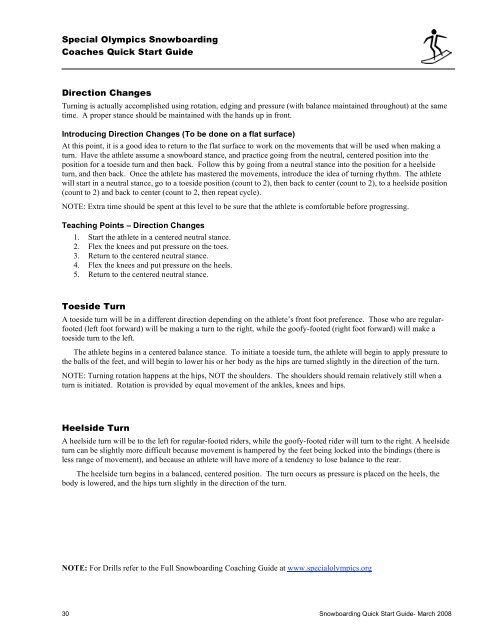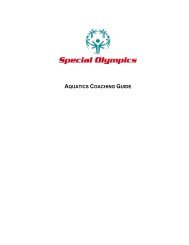N O W B O A R D IN G - Special Olympics
N O W B O A R D IN G - Special Olympics
N O W B O A R D IN G - Special Olympics
Create successful ePaper yourself
Turn your PDF publications into a flip-book with our unique Google optimized e-Paper software.
<strong>Special</strong> <strong>Olympics</strong> Snowboarding<br />
Coaches Quick Start Guide<br />
Direction Changes<br />
Turning is actually accomplished using rotation, edging and pressure (with balance maintained throughout) at the same<br />
time. A proper stance should be maintained with the hands up in front.<br />
Introducing Direction Changes (To be done on a flat surface)<br />
At this point, it is a good idea to return to the flat surface to work on the movements that will be used when making a<br />
turn. Have the athlete assume a snowboard stance, and practice going from the neutral, centered position into the<br />
position for a toeside turn and then back. Follow this by going from a neutral stance into the position for a heelside<br />
turn, and then back. Once the athlete has mastered the movements, introduce the idea of turning rhythm. The athlete<br />
will start in a neutral stance, go to a toeside position (count to 2), then back to center (count to 2), to a heelside position<br />
(count to 2) and back to center (count to 2, then repeat cycle).<br />
NOTE: Extra time should be spent at this level to be sure that the athlete is comfortable before progressing.<br />
Teaching Points – Direction Changes<br />
1. Start the athlete in a centered neutral stance.<br />
2. Flex the knees and put pressure on the toes.<br />
3. Return to the centered neutral stance.<br />
4. Flex the knees and put pressure on the heels.<br />
5. Return to the centered neutral stance.<br />
Toeside Turn<br />
A toeside turn will be in a different direction depending on the athlete’s front foot preference. Those who are regularfooted<br />
(left foot forward) will be making a turn to the right, while the goofy-footed (right foot forward) will make a<br />
toeside turn to the left.<br />
The athlete begins in a centered balance stance. To initiate a toeside turn, the athlete will begin to apply pressure to<br />
the balls of the feet, and will begin to lower his or her body as the hips are turned slightly in the direction of the turn.<br />
NOTE: Turning rotation happens at the hips, NOT the shoulders. The shoulders should remain relatively still when a<br />
turn is initiated. Rotation is provided by equal movement of the ankles, knees and hips.<br />
Heelside Turn<br />
A heelside turn will be to the left for regular-footed riders, while the goofy-footed rider will turn to the right. A heelside<br />
turn can be slightly more difficult because movement is hampered by the feet being locked into the bindings (there is<br />
less range of movement), and because an athlete will have more of a tendency to lose balance to the rear.<br />
The heelside turn begins in a balanced, centered position. The turn occurs as pressure is placed on the heels, the<br />
body is lowered, and the hips turn slightly in the direction of the turn.<br />
NOTE: For Drills refer to the Full Snowboarding Coaching Guide at www.specialolympics.org<br />
30 Snowboarding Quick Start Guide- March 2008

















